Complete Solutions to Electrochemistry of chapter ELECTROCHEMISTRY of Class 12 book with complete answers and questions
| Class 12 | CHEMISTRY |
| Chapter | ELECTROCHEMISTRY |
| NCERT EXEMPLAR | Electrochemistry |
| Number Of Questions | 68 |
| Academic Year | 2023-24 |
Which cell will measure standard electrode potential of copper electrode?
03:18View SolutionElectrode potential for `Mg` electrode varies according to the equation
`E_(Mg^(2+)|Mg)=E_(Mg^(2+)|Mg)^(ϴ) -(0.059)/2 "log" 1/([Mg^(2+)])`
The graph of `E_(Mg^(2+)|Mg) vs log [Mg^(2+)]` is02:43View SolutionWhich of the following statement is correct?
01:45View SolutionThe difference between the electrode potentials of two electrons when no current is drawn through the cell is called:
01:26View SolutionWhich of the following statement is not correct about an inert electrode in a cell?
01:34View SolutionAn electrochemical cell an behave like an electrolytic cell when
01:30View SolutionWhich of the statements about solution of electrolytes is not correct?
02:27View SolutionUsing the data given below:
`E_(Cr_(2)O_(7)^(2-)|Cr^(3+))^(@)=1.33V E_(Cl_(2)|Cl^(-))^(@)=1.36V`
`E_(MnO_(4)^(-)|Mn^(2+))^(@)=1.51V E_(Cr^(3+)|Cr)=-0.74V`
Mark the strongest reducing agent.04:29View SolutionGiven `E_("Cr_(2)O_(7)^(2-)//Cr^(3+))^(@)=1.33V,E_(MnO_(4)^(-)//Mn^(2+))^(@)=1.51V`
Among the following, the strongest reducing agent is `E_(Cr^(3+)//Cr)^(@)=-0.74V^(x),E_(MnO_(4)^(-)//Mn^(2+))^(@)=1.51V`
`E_(Cr_(2)O_(7)^(2-)//Cr^(3+))^(@)=1.33V,E_(Cl//Cl^(-))^(@)=1.36V`
Based on the data given above strongest oxidising agent will be01:46View SolutionUsing the data given below:
`E_(Cr_(2)O_(7)^(2-)|Cr^(3+))^(@)=1.33V E_(Cl_(2)|Cl^(-))^(@)=1.36V`
`E_(MnO_(4)^(-)|Mn^(2+))^(@)=1.51V E_(Cr^(3+)|Cr)=-0.74V`
In which option the order of reducing power is correct?03:03View SolutionUse the data given in Q.8 and find out the most stable ion in its reduced form.
01:25View SolutionUsing the data given below:
`E_(Cr_(2)O_(7)^(2-)|Cr^(3+))^(@)=1.33V E_(Cl_(2)|Cl^(-))^(@)=1.36V`
`E_(MnO_(4)^(-)|Mn^(2+))^(@)=1.51V E_(Cr^(3+)|Cr)=-0.74V`
Find the most stable oxidised species.02:00View SolutionThe quantity of charge required to obtain one mole of aluminium from `Al_(2)0_(3)` is
01:09View SolutionThe cell constant of a conductivity cell
01:14View SolutionWhile charging the lead storage battery:
02:18View Solution`^^_(m_((NH_(4)OH)))^(o)` is equal to
02:52View SolutionIn the electrolysis of aqueous sodium chloride solution which of the hall cell reaction will occur at anode?
01:42View SolutionThe positive value of the standard electrode potential of `Cu^(2+)//Cu` indicates that.......
03:30View SolutionPotential for some half cell reactions are given below. On the basis of these mark the correct answer.
(i) `H^(+)(aq) + e^(-) rightarrow (1/2)H^(2)(g)` `E_(cell)^(@) = 0.00V`
(ii) `2H_(2)O(l) rightarrow O_(2)(g) + 4H^(+)(aq) + 4e^(-)`, `E_(cell) = 1.23V`
(iii) `2SO_(4)^(2-)(aq) rightarrow S_(2)O_(8)^(2-)(aq) + 2e^(-), E_(cell)^(@) = 1.96V`03:14View Solution`E_("cell")^(@)=1.1V` for Daniel cell. Which of the following expressions are correct description of state of equilibrium in this cell?
02:40View SolutionConductivity of an electrolytic solution depends on:
01:15View Solution`A_(m)^(@)H_(2)O` is equal to:
02:07View SolutionWhat will happen during the electrolysis of aqueous solution of `CuSO_(4)` by using platinum electrodes?
02:30View SolutionWhat will happen during the electrolysis of aqu eous solution of `CuSO_(4)` in the presence of Cu electrodes?
02:26View SolutionConductivity k, is equal to ......
02:33View SolutionMolar conductivity of inic solution depends on ........
02:40View SolutionFor the given cell, `Mg|Mg^(2+)||Cu^(2+)|Cu`
03:57View SolutionCan absolute electrode potential of an electrode be measured?
03:02View SolutionCan `E_("cell")^(@)` or `Delta_(r)G^(@)` for cell reaction ever be equal to zero?
02:12View SolutionUnder what condition is `E_("cell")^(@)=0` or `Delta_(r)G=0`?
01:46View SolutionWhat does the negative sign in the expression `E_(Zn^(2+)//Zn)^(@)=-0.76V` mean?
03:06View SolutionAqueous copper sulphate solution and aqueous silver nitrate solution are electrolysed by 1 ampere current for 10 minutes in separate electrolytic cells. Will the mass of copper and silver deposited on the cathode be same of different? Explain your answer.
03:01View SolutionDepict the galvanic cell in which the cell reaction is
`Cu+2Ag^(+)rarr2Ag+Cu^(2+)`02:44View SolutionValue of standard electrode potential for the oxidation of `Cl^(-)` ions is more positive than that of water, even then in the electrolysis of aqueous sodium chloride, why is `Cl^(-)` oxidsied at anode instead of water?
03:19View SolutionWhat is electrode potential?
01:48View SolutionConsider the following diagram in which an electrochemical cell is coupled to an electrolytic cell. What will be the polarity of electrodes 'A' an d 'B' in the electrolytic cell?
 03:07View Solution
03:07View SolutionWhy is alternating current used for measuring resistance of an electrolytic solution ?
02:34View SolutionA galvanic cell has electrical potential of 1.1 V . If an opposing potential of 1.1 V is applied to this cell, what will happen to the cell reaction and current flowing through the cell ?
01:36View SolutionHow will the pH of brine (aq NaCl solution) be affected when it is electrolysed.
02:20View SolutionUnlike dry cell, the mercury cell has a constant cell has a constant cell potential throughout its useful life, why?
01:57View SolutionSolutions of two electrolytes A and B are diluted. The `Lambda_(m)` of 'B' increases 1.5 times while that of A increases 25 times. Which of the two is a strong electrolyte? Justify your answer.
04:37View SolutionWhen acidulated water (dil. `H_(2)SO_(4)` solution) is electrolysed, with pH of the solution be affected? Justify your answer.
02:41View SolutionIn an aqueous solution how does specific conductivity of electrolytes change with additon of water?
05:52View SolutionWhich reference electrode is used to measure the electrode potnetial of other electrodes?
02:12View SolutionConsider a cell given below.
`Cu|Cu^(2+)|Cl^(-)|Cl_(2).Pt`
Write the reactions that occur at anode and cathode.02:38View SolutionWrite the Nernst equation for the cell reaction in the Daniel cell. How will the `E_("cell")` be affected when concentration of `Zn^(+)` ions is increased?
04:11View SolutionWhat advantage do the fuel cells have over primary and secondary batteries?
05:57View SolutionWrite the cell reaction of a lead storage battery when it is discharged. How does the density of the electrolyte change when the battery is discharged?
04:55View SolutionWhy on dilution the `Lambda_(m)` of `CH_(3)COOH` increases drastically, while that of `CH_(3)COONa` increases gradually?
07:24View SolutionMatch the terms given in column I with the units given in column II.
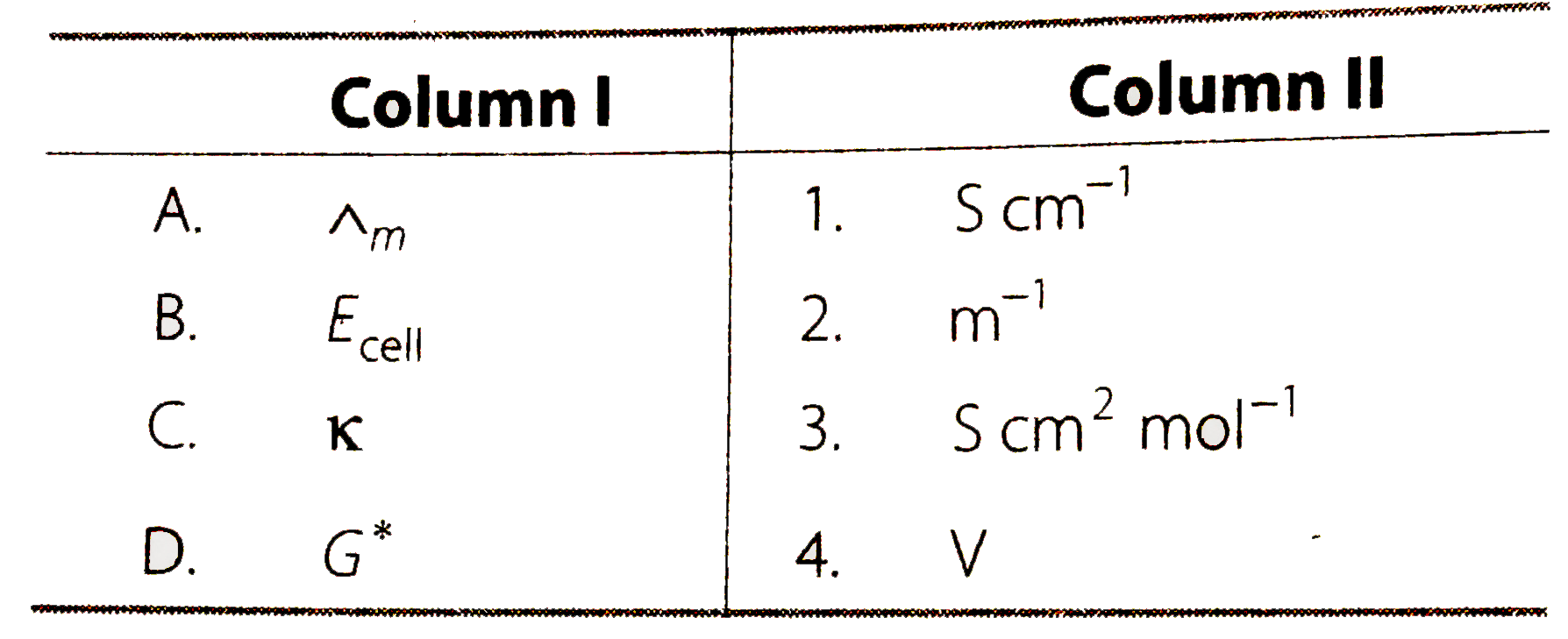 05:52View Solution
05:52View SolutionMatch the terms given in Column I with the items given in Column II. (One to one match only)
 02:39View Solution
02:39View SolutionMatch the items of Column I and Column II.
 05:30View Solution
05:30View SolutionMatch the items of Column I and Column II.
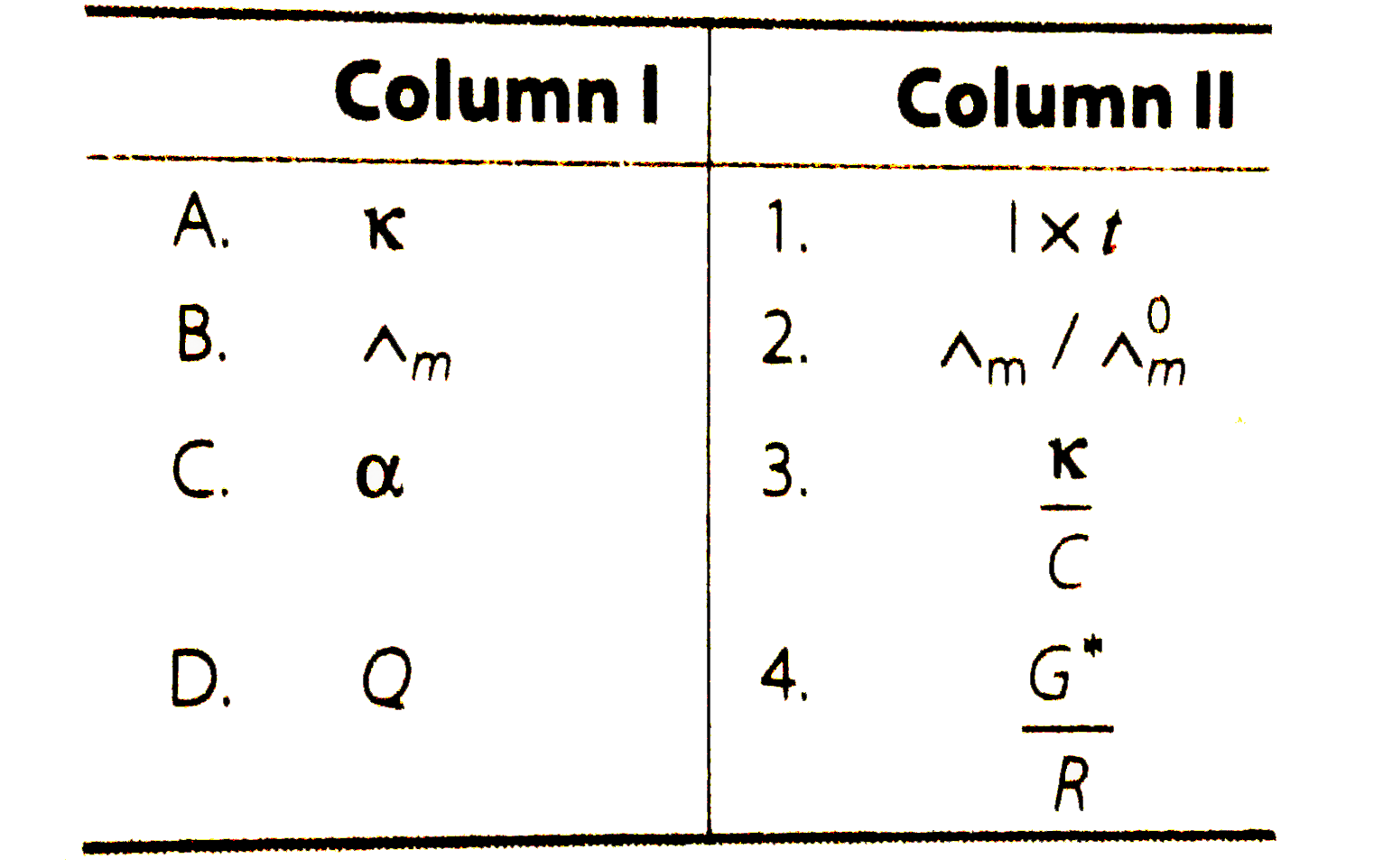 05:01View Solution
05:01View SolutionMatch the items of Column I and Column II.
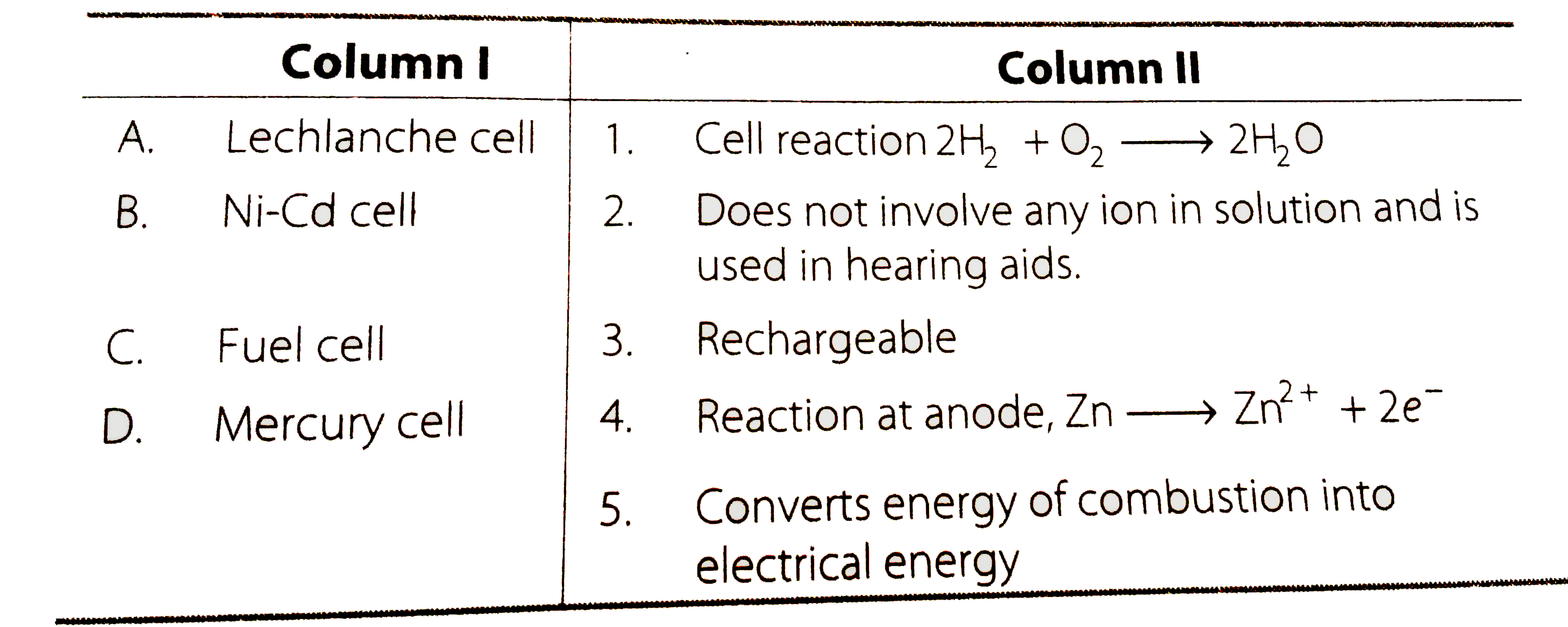 04:49View Solution
04:49View SolutionMatch the items of Column I and Column II on the basis of data given below:
(One to one match only)
`E_(F_(2)|F^(-))^(@)` = 2.87 V, `E_(Li^(+)|(Li)` = -3.5 V,
`E_(Au^(3+)|Au)^(@)` = 1.4 V, `E_(Br_(2)|Br^(-))^(@)` = 1.09V
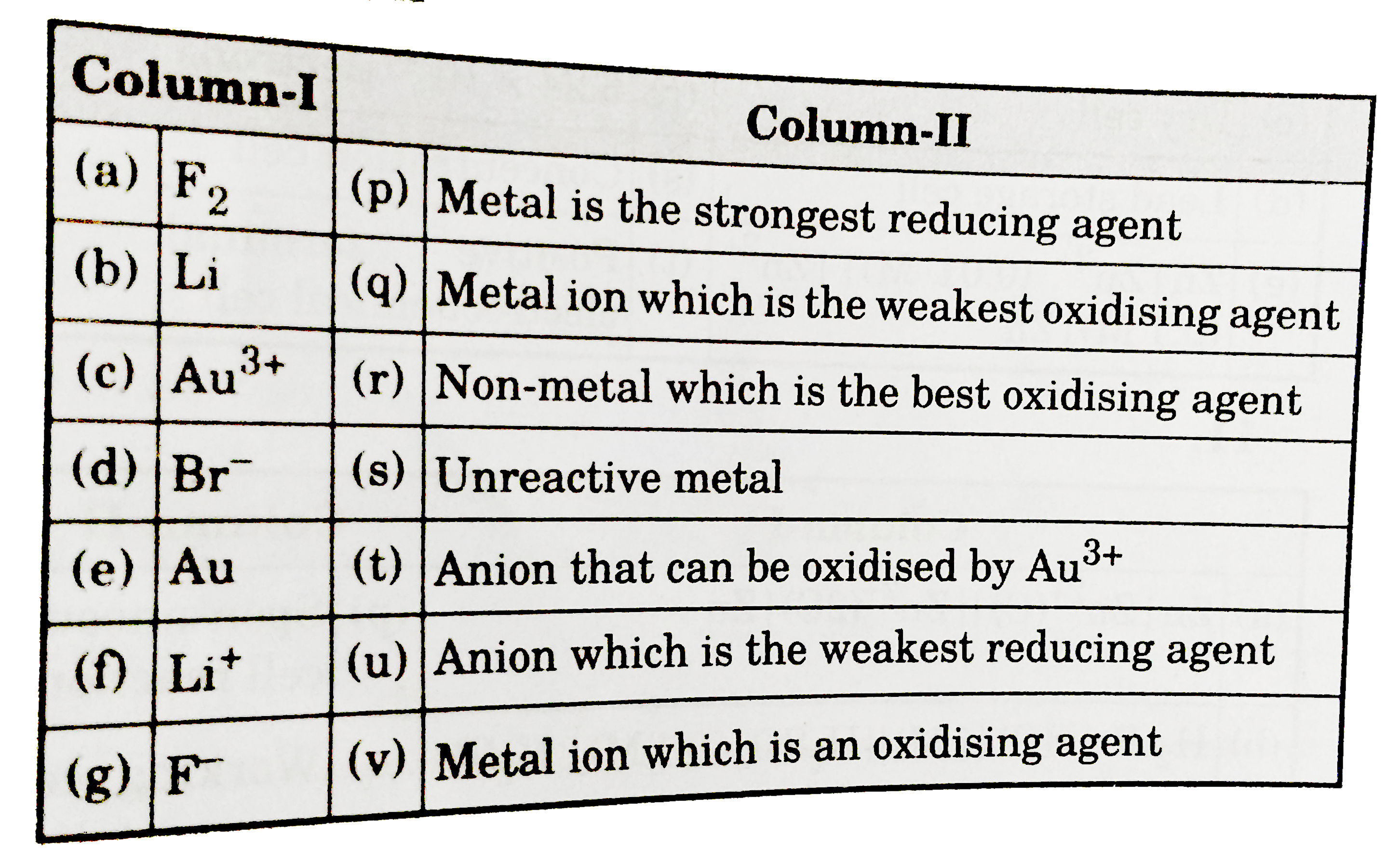 06:01View Solution
06:01View SolutionAssertion(A) Cu is less reactive than hydrogen.
Reason(R) `E_(Cu^(2+)//Cu)^(o+)` is negative.02:49View SolutionAssertion (A) `E_("cell")` should have a positive value for the cell to function,
Reason(R) `E_("cathode")ltE_("anode")`03:23View SolutionAssertion (A) Conductivity of all electrolytes decreases on dilution.
Reason(R) On dilution number of ions per unit volume decreases.01:50View SolutionAssertion(A) `Lambda_(m)` for weak electrolytes shows a sharp increase when the electrolytic solution is diluted.
Reason(R) For weak electrolytes degree of dissociation increases with dilution of solution.02:10View SolutionSTATEMENT-1: The voltage of mercury cell remains constant for longer period of time.
STATEMENT-2: It is because net cell reaction does not involve ions.02:07View SolutionAssertion (A): Electrolysis of NaCl solution gives chlorine at anode instead of `O_(2)`.
02:52View SolutionAssertion : For measuring resistance of an ionic solution an AC source is used.
Reason : Concentration of ionic solution will change if DC source is used.02:01View SolutionAssertion : Current stops flowing when `E_(cell)=0`.
Reason : Equilibrium of the cell reaction is attained.01:34View SolutionAssertion (A): `E_(Ag^(+)//Ag)` increases with increase in concentration of `Ag^(+)` ions.
Reason (R): `E_(Ag^(+)//Ag)` has a positive value.02:29View SolutionAssertion (A) Copper sulphate can be stored in zinc vessel.
Reason(R) Zinc is less reactve than copper.02:43View SolutionConsider the figure and answer the following question.
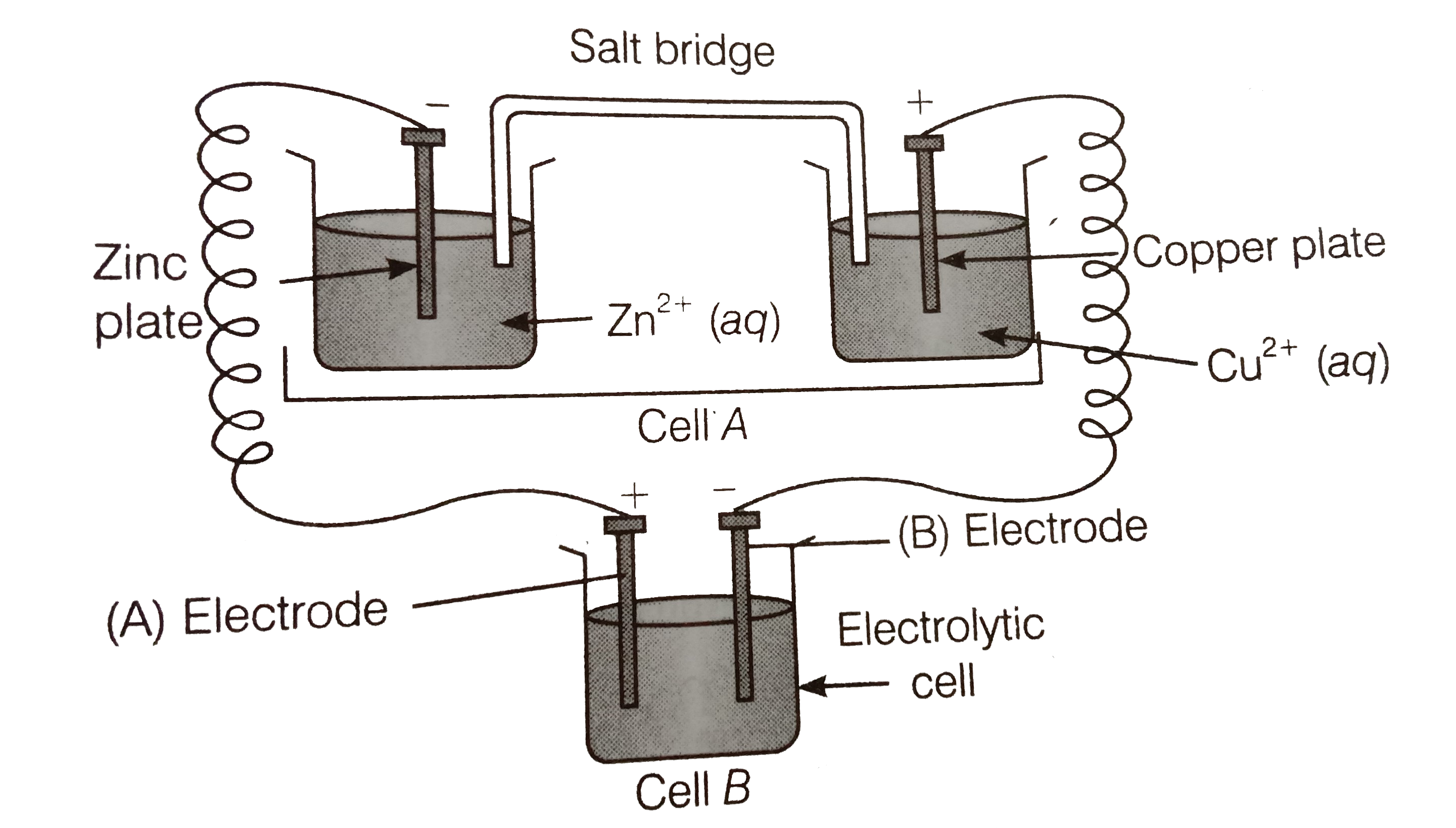
(i) Cell 'A' h as `E_("cell")=2V` and Cell 'B' has `E_("cell")=1.1V` which of the two cell 'A' or 'B' will act as an electrolytic cell. Which electrode reactions will occur in this cell?
(ii) If cell 'A' has `E_("cell")=` 0.5V and cell 'B' has `E_("cell")`=1.1V then what will be the reactions at anode and cathode?05:12View SolutionConsider figure from the above question and answer the questions (i) to (vi) given below.
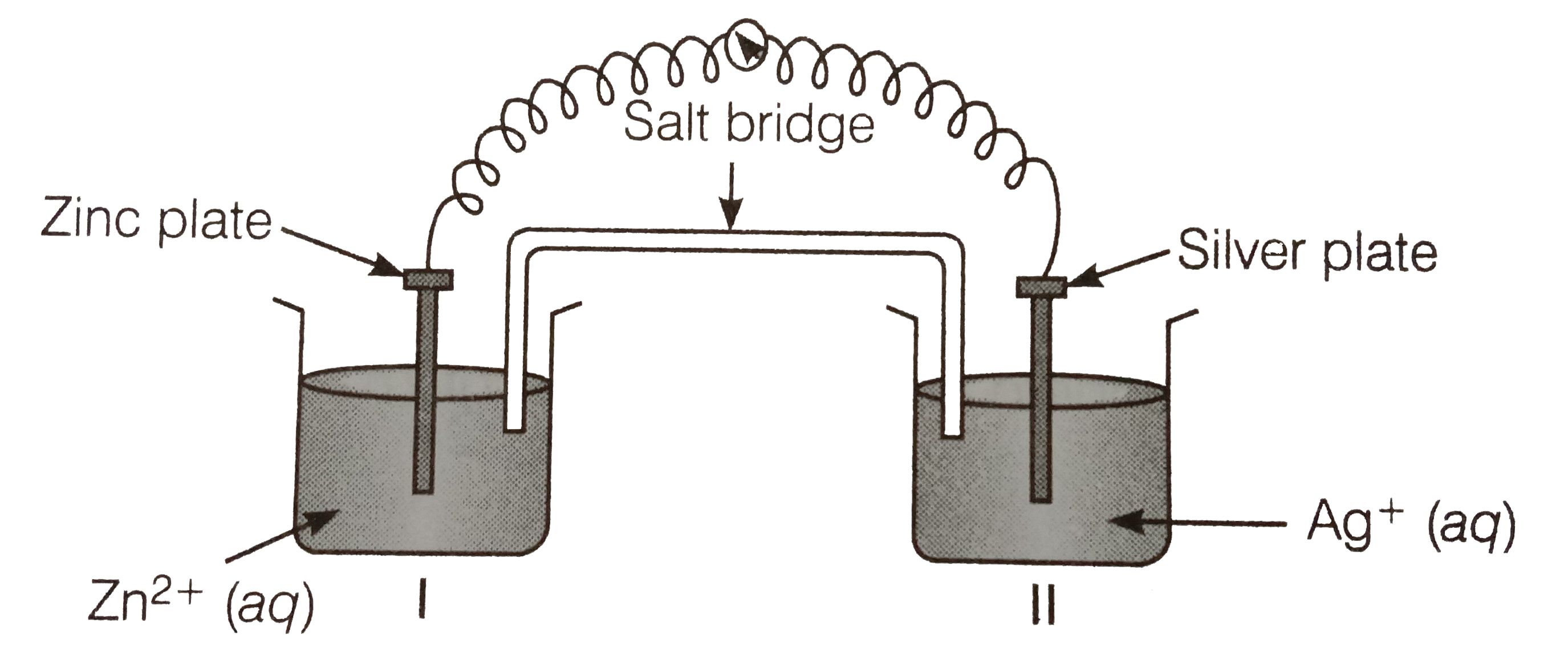
(i) Redraw the diagram to show the direction of electron flow.
(ii) Is silver plate the anode or cathode?
(iii) what will happen it salt bridge is removed?
(iv) When will the cell stop functining?
( v) How will concentration of `Zn^(2+)` ions and `Ag^(+)` ions be affected when the cell function?
(vi) How will the concentration of `Zn^(2+)` ions and `Ag^(+)` ions be affected after the cell becomes dead?09:04View SolutionWhat is the relationship between Gibbs free energy of the cell reaction in a galvanic cell and the emf of the cell ? When will the maximum work be obtained froma galvanic cell ?
01:12View Solution
Electrochemistry questions and complete solutions for chapter ELECTROCHEMISTRY of CHEMISTRY of Class 12
